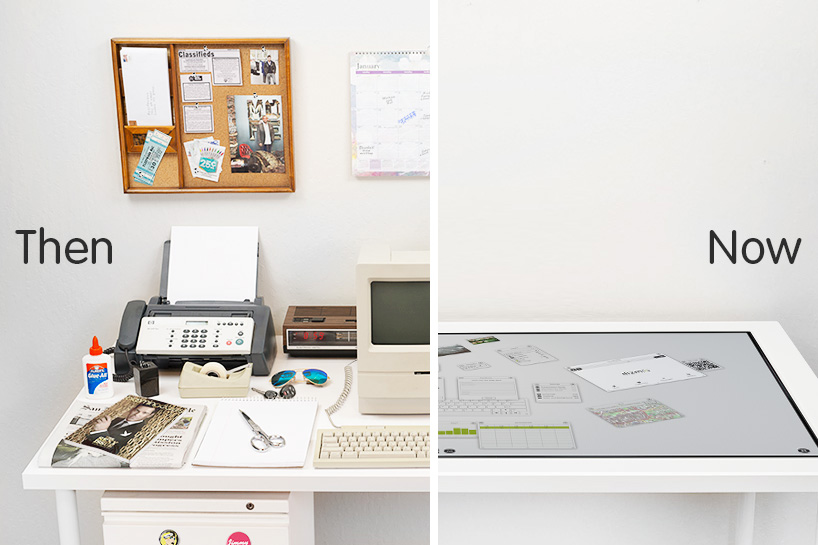The future of the workplace
It’s no secret that over the last four decades the computer has replaced much of the technology that originally required us to work in an office. Paper trails that needed to be kept under lock and key can now be recorded and accessed easily through electronic means, whilst the internet has made a range of communication technologies obsolete, from faxes and letters, to even phones. On top of this, improvements in infrastructure have enabled us to have conversations with people around the world from the comforts of our own home.

Scene of the “Evolution of the Desk” video (by Harvard Innovation Lab) fronting dizmo on a horizontal touchscreen
All of the above goes some way to explaining people’s inability to see that the era of the computer and the desk is coming to an end. When the computer has replaced so much of our day to day working lives, how could it ever upend itself?
But for those in the know, it’s hard to see the humble desk, for which many of us sit for upwards of 7 hours a day, remaining a fixture in our working lives for the foreseeable future. It’s looking more and more likely that the office and desk of the future will look a little different due to a number of factors:
Collaboration is Key
A recent study estimated that what we think of as the ‘corporate ladder’ has actually become more of a corporate lattice over the last 25 years, with 25% of management positions having been flattened out and a more entrepreneurial structure taking place, one where employees can more directly access the CEO and take control of projects rather than going through a hierarchy. Most of this is due to a new need for businesses to move away from efficiency based models and into something that’s more agile and better suited to adaptability. This flattened structure enables greater innovative thinking across departments, however it also requires a better way to scale collaboration.
One of the ways this will be done is through the surfaces we interact with on a day to day basis. Valve, the video game company, create mobility by giving their employees desks on wheels, so they can frequently move around depending on what project their working on, but more technological solutions exist. In the future, conference tables, screens and walls will all work via the cloud and be interactive.
Open plan offices have long been thought of as improving productivity and collaboration, and with further evolutions, a wall will no longer be just a wall, but another way for users to communicate not just with other people in the office, but with collaborators across the world.
We’re fast approaching the point where legacy ‘desktop-centred’ methods of the past two decades are reaching their upper limits. Borderless technologies are breaking the siloes, and those “clogging points” in the information throughput – between devices, machines, users and even the physical rooms in the offices, are being opened. Soon, Workplace 3.0 will be an environment led by digital dexterity, and even AI to reduce the cognitive load in the day to day.
Flexible, Smarter Working
At the moment there are clogging points in the siloes in which we currently try to work. App siloes, data siloes, user siloes, physical siloes, task management siloes all are limiting factors that contain our potential to collaborate at speed. It goes back to the visualisation paradigm of 1 app per screen visualisation. In the future, intelligent workplace apps will connect to each other to reveal work holistically, not in siloes. One way this is already being done is through the use of intelligent workspaces that turn these siloes into “nodes” in a larger control system.
These intelligent workspaces provide users interoperability across a range of data and cross compatibility for a range of apps that wouldn’t normally be able to interact with each other. By giving these siloes access to each other through a common platform, barriers to collaboration will be dramatically reduced.
Yet the ability to collaborate won’t just improve our jobs as they currently stand. In fact our jobs will likely change because of these evolutions, just like the evolution of computing changed our jobs over the last 20 years. Recent studies estimate that in the next two decades over half of America’s jobs could be performed by AI and bots. The Workplace 3.0 is a dramatic departure from the Workplace 2.0 with the white collar work 90’s landscape being disrupted by borderless technology, even smarter devices, social media amplifying every impact and digital natives who are 24/7.
The evolution of the desktop isn’t just placing screens on every surface to make them interactive. There’s tangible benefits to creating a system where data points and applications can remain solo when needed, but can still collaborate and share data efficiently too. With these new improvements, job roles will change, new forms of working will be unlocked, and some tasks will become automated, enabling us to spend more time coming up with creative solutions to the problems of tomorrow.
Last updated: January 21, 2019
